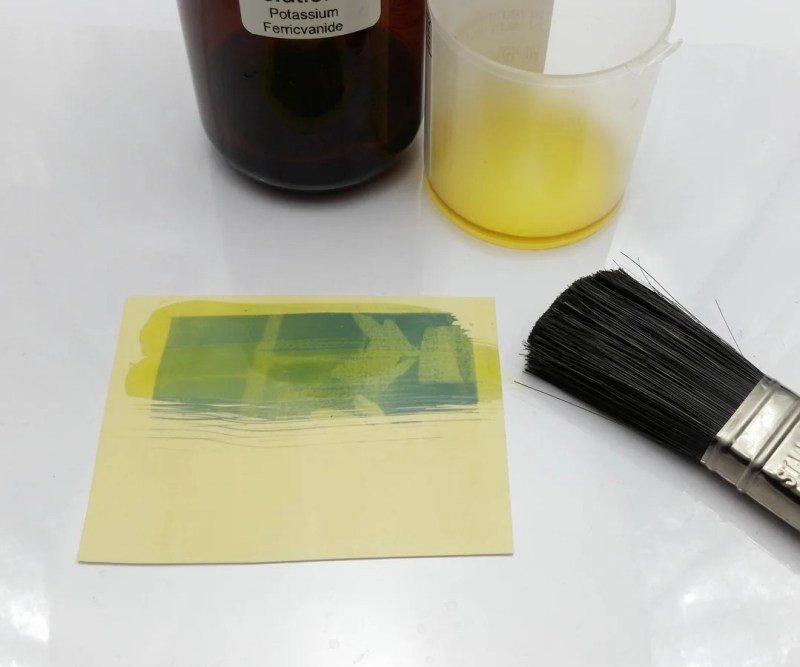While most photographers have moved on to digital cameras with their numerous benefits, there are a few artists out there still taking pictures with film. While film is among the more well-known analog photographic methods available, there are chemically simpler ways of taking pictures available for those willing to experiment a little bit. Cyanotype photography is one of these methods, and as [JGJMatt] shows, it only takes a few commonly available chemicals, some paper, and a slightly modified box camera to get started.
Cyanotype photography works by adding UV-reactive chemicals to paper and exposing the paper similarly to how film would be exposed. The photographs come out blue wherever the paper wasn’t exposed and white where it was. Before mixing up chemicals and taking photos, though, [JGJMatt] needed to restore an old Kodak Brownie camera, designed to use a now expensive type of film. Once the camera is cleaned up, only a few modifications are needed to adapt it to the cyanotype method, one of which involves placing a magnet on the shutter to keep it open for the longer exposure times needed for this type of photography. There is some development to do on these pictures, but it’s relatively simple to do in comparison to more traditional chemical film development.
For anyone looking for a different way of taking photographs, or even those looking for a method of taking analog pictures without the hassle of developing film or creating a darkroom, cyanotype offers a much easier entry point and plenty of artists creating images with this method don’t use a camera at all. There are plenty of other photographic chemistries to explore as well; one of our favorites uses platinum to create striking black-and-white photos.















Complains 620(120) film is hard to buy and develop. proceeds to buy shopping list of chemicals. I get doing things like this for fun. but no need to make up reasons why this way is “better”.
They link kits which are supposedly 275mL of each solution, which if they’re as efficient as this guy says should be something like 34 exposures per dollar. Of course, it’s not as good of image as regular film, but then regular film isn’t as good as digital for regular photos, so at least this seems kind of neat.
You’ve obviously never seen fine-grain large format film, properly processed and printed.
Even if detail was the only thing that mattered, there’s a problem. The best *films* can hold quite a bit of detail if you use a larger format. But as for lenses… if you want to beat the best modern 35mm lenses with vintage glass of any size, you’re looking at uncommon and expensive lenses as far as I can tell. And there’s also medium format digital cameras with their matching lenses to compare against, not just 35mm any more. Plus, the digital user can gain quite a bit of detail by things like pixel shift super resolution.
ebay listings for Goerz Dagor lenses, focal length 12″ or so, run from less than $400 to more than $1000. Some are over 100 years old. The only test results I found indicated diffraction limited performance at f/22 near center.
If they could maintain the same sharpness at the edges as f/22 diffraction has limited them to in the center, that would be great, but at the edges they probably couldn’t resolve more than a few light/dark line pairs per millimeter. I’ve been told there’s 35mm lenses that are supposed to be sharp enough to be just barely sensor-limited around 50 megapixels now. So, in that case they are probably around 120 line pairs per mm across the whole frame, which is just crazy if I’ve understood properly, and means to get the same detail I’m pretty sure you’d need larger than 8×10 at a realistic lp/mm figure regardless of every other stat. But that gets beyond how much I have looked into old formats.
> Complains 620(120) film is hard to buy and develop
120 can be developed very nicely with the cheapest instant coffee and washing soda from your village grocer. (google “caffenol”)
620 spools are outrageously over-priced, but once you have 2, with a bit of practice you can re roll 120 onto them using an old hoodie as a dark bag.
A blueprint for a return to the future.
You can only make one print with this technique, has he considered trying overhead projector printer paper to make “negatives”, apply the chemicals to the transparency (if it will hold ink it should hold the chemicals), expose it as normal, develop it as normal and you should have a transparent picture that could be used as a negative for making prints. Just a thought.
Doesn’t this use cyanide? Rats! Thinks of the rats.
No.
I applaud the experimental nature of this project. In the 80s and 90s, I produced a lot of experimental fine art photography, including photographic cyanotypes. The 120 film used in cameras such as this is readily available and less than $10 a roll. The chemicals to create a cyanotype, ferric ammonium citrate and potassium ferrocyanide do not cost much as well. The exposure times for this process through a camera lens and this process would be crazy long. But, hey, to each his own. If it were me, I’d shoot on film, enlarge onto transparency film and contact print the blue print.
But keep experimenting!